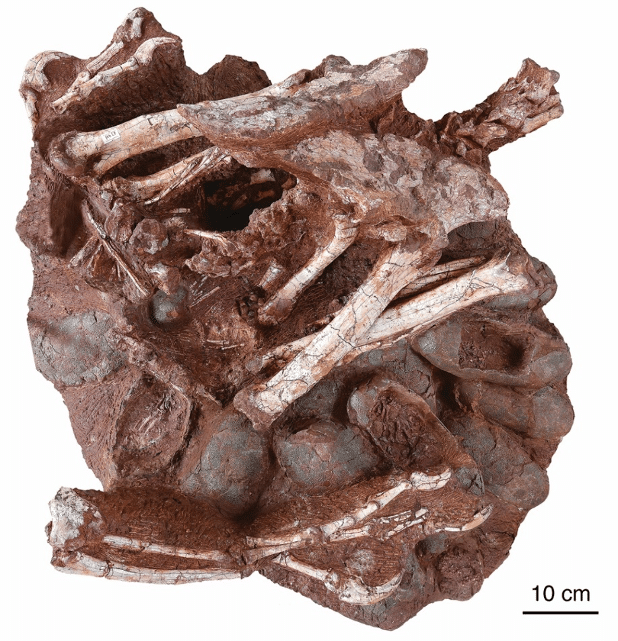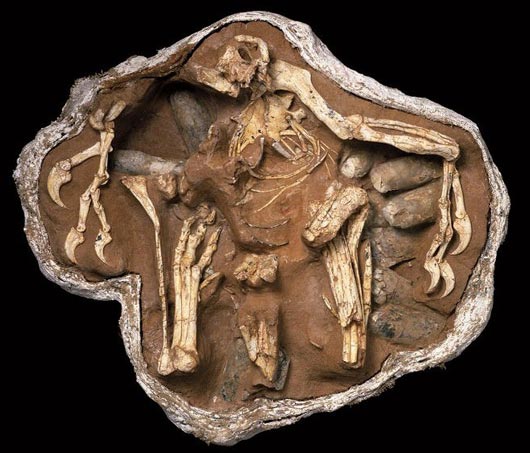Rare Oviraptorid Fossil Overturns Ideas on Late Stage Egg Incubation
Fossil of Dinosaur Sitting on Eggs (Late Stage Incubation)
Fossils of dinosaurs are rare, fossils of articulated dinosaur skeletons rarer still and any fossils that preserve evidence of behaviour, these are amongst the rarest of all, truly scientific treasures. A newly published paper describes the fossilised remains of a Late Cretaceous oviraptorid from east China’s south-eastern Jiangxi Province, a specimen that ticks all these boxes. The fossils represent the partial, articulated remains of oviraptorosaur preserved sitting on a clutch of eggs in a brooding position. Such fossils have been found before, but uniquely these 70-million-year-old remains include fossils of baby dinosaurs preserved inside the eggs, the first time this has been recorded in the non-avian dinosaur fossil record.
The Partially Preserved Adult Oviraptorid On the Nest

The fossilised remains of an oviraptorid with preserved eggs that contain the remains of baby dinosaurs. Note scale bar = 10 cm.
Picture credit: Shundong Bi et al (Science Bulletin)
Sitting Atop a Dinosaur Nest
The multinational team of researchers includes Dr Shundong Bi (Indiana University of Pennsylvania) and Xing Xu (Institute of Vertebrate Palaeontology – Beijing) along with Dr Matt Lamanna (Carnegie Museum of Natural History) and scientific illustrator Andrew McAfee.
Commenting on the significance of this discovery, Dr Bi stated:
“Dinosaurs preserved on their nests are rare, and so are fossil embryos. This is the first time a non-avian dinosaur has been found, sitting on a nest of eggs that preserve embryos, in a single spectacular specimen.”
Fossils of brooding dinosaurs have been found before, perhaps the most famous is “Big Mamma” the fossilised remains of an adult Citipati osmolskae (also an oviraptorid) on display at the American Museum of Natural History (New York).
Citipati osmolskae Fossil Sitting Atop a Nest of Eggs
Picture credit: The American Museum of Natural History
An Oviraptorid – A Very Bird-like Dinosaur
The Chinese fossil material has been assigned to the Oviraptoridae, although Everything Dinosaur are not aware of any new taxon being announced. Oviraptorid dinosaurs are mainly associated with Asia, but the closely related Caenagnathidae are also known from North America. The bones of these dinosaurs are very bird-like and they do belong to a great linage of theropods that are related to modern birds (the Maniraptora).
The specimen represents an incomplete, articulated skeleton of a large, (presumably adult) oviraptorid crouched in a bird-like brooding posture over a clutch of at least twenty-four eggs. The adult appears to have perished whilst brooding the clutch. The researchers identified the preserved remains of seven unhatched dinosaurs entombed inside the eggs. The late stage of development of the embryos suggests that, just like modern birds, oviraptorids brooded their eggs, rather than simply guarding them as observed in extant crocodilians.
A Caring Parent
Dr Lamanna explained:
“This kind of discovery, in essence, fossilised behaviour, is the rarest of the rare in dinosaurs. Though a few adult oviraptorids have been found on nests of their eggs before, no embryos have ever been found inside those eggs. In the new specimen, the babies were almost ready to hatch, which tells us beyond a doubt that this oviraptorid had tended its nest for quite a long time. This dinosaur was a caring parent that ultimately gave its life while nurturing its young.”
As part of their research, the scientists conducted an oxygen isotope study that demonstrated that the eggs were incubated at high bird-like temperatures, further evidence to support the idea that the adult died whilst brooding its clutch of eggs. Analysis of the tiny baby dinosaur bones preserved inside their eggs indicate that some babies were more fully developed than others, this suggests that the eggs might have hatched at different intervals, a hatching strategy known as asynchronous hatching. This strategy is found in many types of birds today such as Shoebill storks and numerous species of birds of prey such as raptors and owls.
Oviraptorids – Evidence that they were Caring Parents

A pair of oviraptorosaurs. Scientists suggest that these dinosaurs incubated their eggs and that they were caring parents.
Picture credit: Mike Skrepnick
Asynchronous hatching appears to have evolved independently in oviraptorids and modern avians.
The Evolutionary Benefits of Asynchronous Hatching
If the eggs of oviraptorids did hatch at different intervals, then this too can provide an insight into the behaviour of these Late Cretaceous dinosaurs. Biologists have identified a number of reasons why some kinds of bird alive today have evolved asynchronous hatching.
The evolutionary benefits of asynchronous hatching:
- To reduce the losses from predators due to the whole brood not being present in the nest at the same time.
- The younger animals are a back-up plan in case earlier hatched animals die.
- When food resources are scarce the adults can dedicate the bulk of these scarce resources to the older babies and let the younger siblings perish.
- Reduces the demands on the parents as they do not have to care for all the babies at the same time.
Gastroliths Identified
The researchers also noted the presence of gastroliths (stomach stones). A cluster of tiny pebbles had accumulated in the body cavity of the adult dinosaur. Gastroliths are associated with many different types of dinosaur, but this is the first time that undoubted gastroliths have been found in an oviraptorid. As such, these stones may provide new insights into the diets of these very bird-like dinosaurs.
Dr Xu concluded:
“It’s extraordinary to think how much biological information is captured in just this single fossil. We’re going to be learning from this specimen for many years to come.”
To read a related article on dinosaur parenting skills: Doting Fathers – A Parenting Strategy Amongst the Dinosauria.
Everything Dinosaur acknowledges the assistance of a press release from the Carnegie Museum of Natural History (Pennsylvania).
The scientific paper: “An oviraptorid preserved atop an embryo-bearing egg clutch sheds light on the reproductive biology of non-avialan theropod dinosaurs” by Shundong Bi, Romain Amiot, Claire Peyre de Fabrègues, Michael Pittman, Matthew C. Lamanna, Yilun Yu, Congyu Yu, Tzuruei Yang, Shukang Zhang, Qi Zhao and Xing Xu published in Science Bulletin.
Visit Everything Dinosaur’s website: Visit Everything Dinosaur.


